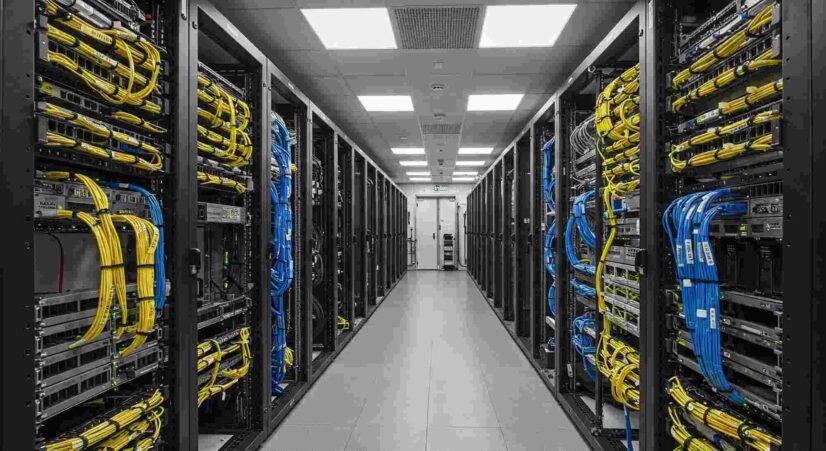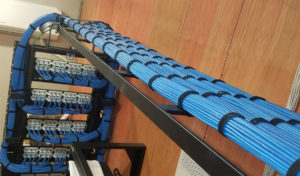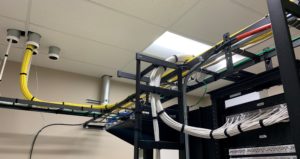In today’s rapidly evolving business landscape, technology is the backbone of every successful operation. Whether you’re managing a corporate office, a healthcare facility, a manufacturing plant, or a retail business, your IT infrastructure’s reliability directly impacts productivity, security, and growth.
At the heart of this infrastructure is structured cabling — the silent yet powerful foundation that supports data, voice, and security systems. For businesses in Noblesville and throughout Central Indiana, Taylored Systems provides expert structured cabling as part of comprehensive Business IT Support & Security Solutions Noblesville companies rely on to meet current demands and prepare for future growth.
With more than 40 years of experience in technology services, Taylored Systems understands the nuances of structured cabling and its critical role in business success. In this article, we explore what structured cabling entails, its benefits, common mistakes businesses make when implementing cabling systems, and why Taylored Systems is the partner Noblesville businesses trust.

What Do We Mean By 'Structured Cabling?'
When we talk about structured cabling, we’re referring to a carefully organized and standardized system of cables, connectors, and hardware that forms the backbone of a business’s IT and communication infrastructure. This cabling backbone supports your data networks and ensures high-performance connectivity across your organization. Unlike ad-hoc wiring — where cables are added haphazardly over time — structured cabling is designed with purpose, scalability, and efficiency in mind. It serves as a comprehensive solution that supports data networks, telephone systems, security cameras, and building management systems, all running seamlessly through a single, well-planned network. Our structured cabling solutions are designed to reliably support security cameras and other essential infrastructure. Whether installing or upgrading telephone systems, you need cabling that meets both voice and future-ready requirements.
A structured cabling system typically includes six key components: entrance facilities, equipment rooms, backbone cabling, horizontal cabling, telecommunications rooms, and work area components. Each of these elements is installed according to industry standards that ensure optimal performance, safety, and ease of maintenance.
In practical terms, structured cabling provides a “future-ready” foundation for businesses in Noblesville. It allows for simple expansion when adding new employees, technology upgrades, or reconfiguring office space. With structured cabling, businesses can quickly adapt without ripping out existing infrastructure or facing costly downtime.
At Taylored Systems, structured cabling means more than just running wires. It’s about building a system that aligns with business goals, accommodates growth, and eliminates inefficiencies. Our structured cabling solutions are clean, organized, and thoroughly labeled, making ongoing maintenance and troubleshooting easy. Whether it’s copper cabling, fiber optic installations, or a hybrid solution, structured cabling from Taylored Systems is a smart investment in your business’s reliability and long-term success. If your Noblesville facility requires fiber optic installations for high-speed backbone connections, our team has deep expertise.
The Benefits of Structured Cabling for Noblesville Businesses
A professionally designed and installed structured cabling system offers numerous advantages that go beyond clean wiring. For Noblesville businesses, these benefits translate into measurable performance improvements and cost savings.
Improved Network Performance
Structured cabling eliminates tangled wiring and reduces electromagnetic interference, resulting in faster data transmission and fewer network disruptions. It allows businesses to run multiple systems — data, voice, and video — over a single network without performance degradation.
Scalability and Flexibility
As businesses grow and evolve, their technology requirements change. Structured cabling systems are designed to scale easily. Whether adding new workstations, expanding office space, or integrating new technologies, structured cabling supports these changes without costly rework.
Simplified Maintenance and Troubleshooting
Because structured cabling is organized and labeled, it significantly reduces the time required for maintenance and troubleshooting. This translates into reduced downtime and lower operational costs.
Future-Proof Investment
Technology changes quickly. Structured cabling systems are built to support future upgrades, making them a long-term investment that pays dividends as your business adopts new technologies.
Common Mistakes Businesses Make with Structured Cabling
Despite its importance, many businesses overlook key aspects of structured cabling during planning and implementation. These oversights can compromise system performance, reduce efficiency, and lead to costly repairs or full system overhauls down the road. Taylored Systems helps Noblesville businesses avoid these pitfalls by offering professional guidance and industry expertise.
Underestimating Future Needs
Businesses often design cabling systems based on current needs, ignoring the potential for growth. This short-term approach can result in capacity constraints and expensive rework. As business operations expand, the need for additional workstations, connected devices, and bandwidth grows.
Without built-in scalability, businesses face disruptions and mounting costs to replace or supplement insufficient infrastructure. Taylored Systems emphasizes designing with flexibility, allowing your business to grow without costly downtime.
Poor Planning and Design
Without a clear plan, cabling systems can quickly become disorganized and inefficient. Misplaced outlets, improper cable pathways, and inadequate labeling make future upgrades confusing and difficult. Additionally, lack of planning can lead to overcrowded conduit space and tangled server rooms, both of which increase maintenance complexity. Taylored Systems takes a holistic design approach, considering the building layout, department functions, and future technology requirements to deliver smart, organized solutions.
Ignoring Industry Standards
Structured cabling must adhere to industry standards for safety, performance, and reliability. Cutting corners with inferior materials or disregarding standards may save money initially but often results in system failures, compliance violations, and long-term expenses. Taylored Systems follows BICSI and TIA/EIA standards, ensuring that each installation is safe, durable, and high-performing.
DIY Installations
Some businesses attempt to handle structured cabling in-house without the proper training or tools. DIY installations can lead to misrouted cables, electrical interference issues, and inconsistent connections. Safety hazards, code violations, and network instability are common risks. Taylored Systems employs certified technicians who perform professional installations, backed by thorough testing and documentation.
Choosing the Wrong Cabling Types
Using outdated or incompatible cables can throttle network performance and limit future expansion. Selecting the right cable types — such as Category 6A or fiber optic cabling — is essential for supporting today’s data-intensive operations and tomorrow’s advancements. Taylored Systems advises clients on the right materials and solutions that balance current needs and future growth.
Industry-Specific Structured Cabling Solutions
Taylored Systems specializes in designing structured cabling systems that address the unique needs of various industries in Noblesville. Each industry has distinct operational demands, regulatory requirements, and growth patterns. Our expertise allows us to tailor solutions that support current workflows while preparing for future advancements.
Healthcare Facilities
Hospitals and clinics require high-speed, secure data transmission for patient records, diagnostic equipment, and communication systems. Structured cabling supports HIPAA compliance and ensures that life-saving technology runs without interruption.
From electronic health record systems to nurse call stations and real-time patient monitoring, healthcare environments rely on continuous, dependable connectivity. Taylored Systems designs healthcare cabling infrastructures with redundancy and scalability to handle increasing data volumes and meet evolving medical technology standards.
Corporate Offices
For corporate environments, structured cabling supports unified communications, data transfer, and security systems. It allows businesses to integrate VoIP systems, conference room technology, and robust internet connectivity. Whether your organization is implementing hybrid work solutions, cloud services, or advanced collaboration tools, Taylored Systems ensures your cabling infrastructure is ready. We also prioritize neat installations and accessible cable management, creating organized IT environments that are easy to maintain and expand.
Manufacturing and Warehouses
Industrial environments demand durable and reliable cabling solutions that withstand harsh conditions. Structured cabling supports automation systems, security cameras, and industrial IoT devices, all while maintaining high-speed data flow.
We design industrial-grade cabling systems that can handle environmental stress, temperature fluctuations, and electrical interference. We build solutions that support robotics, real-time production monitoring, and predictive maintenance technologies — keeping manufacturing operations efficient and secure.
Retail Stores
Retail businesses rely on structured cabling for point-of-sale systems, inventory management, digital signage, and customer Wi-Fi. A reliable cabling system ensures smooth operations and enhances the customer experience. We delivers solutions that support omnichannel shopping, integrated payment processing, and data-driven customer engagement strategies.
Educational Institutions
Schools and universities need structured cabling to support online learning platforms, security systems, and administrative operations. Proper cabling enables high-speed connectivity throughout campuses. We design infrastructures that accommodate interactive classrooms, campus security networks, and future technology initiatives, ensuring students and staff stay connected and protected.
Why Noblesville Businesses Choose Taylored Systems for Structured Cabling
With so many factors to consider, partnering with an experienced provider is crucial. Here’s why Taylored Systems is the trusted choice for structured cabling in Noblesville.
Expert Consultation and Site Assessments
We begin every project with an in-depth site assessment to evaluate your current infrastructure and future goals. This ensures that our designs meet both immediate needs and long-term objectives. Our consultative approach involves analyzing building layouts, understanding your organization’s operational flow, and identifying high-priority areas that require robust connectivity. We take the time to listen, ensuring we fully understand your business challenges and aspirations before making recommendations.
Custom System Design
Every business is unique, and our team designs structured cabling systems tailored to your operations. We consider factors such as building layout, industry requirements, and scalability. From planning cable pathways that minimize disruption to recommending future-proof technologies like Category 6A or fiber optic cabling, our designs are built to support growth and flexibility. Whether it’s a new office build-out, facility expansion, or technology refresh, Taylored Systems creates solutions that align with your business trajectory.
Professional Installation and Quality Assurance
Our certified technicians ensure that every cable is installed to the highest standards, following industry best practices and safety protocols. We conduct thorough testing to guarantee system reliability. This includes signal integrity testing, certification documentation, and verifying that all endpoints meet performance expectations. We pride ourselves on clean, organized installations that make future maintenance simple and efficient.
Ongoing Support and Maintenance
Structured cabling is not a one-time project. Taylored Systems provides ongoing maintenance, system audits, and updates to ensure your infrastructure continues to perform as your business evolves. Our proactive service model means we don’t wait for issues to arise — we help prevent them.
Local Expertise and Community Commitment
With deep roots in Central Indiana, we understand the needs of Noblesville businesses. Our local presence means fast response times and personalized service. We’re not just a vendor; we’re a partner invested in helping local businesses grow and succeed.
The Importance of Future-Proofing Your Cabling Infrastructure
Technology is advancing faster than ever, and businesses must stay ahead. Future-proofing your cabling infrastructure means investing in solutions that will support emerging technologies like 5G, cloud computing, and smart building automation. Without proper planning, businesses risk costly upgrades, network slowdowns, and compatibility issues in the years ahead.
The Role of Fiber Optic and High-Performance Cabling
Fiber optic cabling, for example, offers virtually unlimited bandwidth and is ideal for data-intensive operations. As businesses rely more on cloud-based applications and real-time data analytics, fiber ensures they have the capacity and speed to keep up. For companies that need rapid data transfer between servers, secure off-site backups, or seamless video conferencing capabilities, fiber optic cabling is becoming essential.
Similarly, Category 6A cabling supports 10-Gigabit Ethernet, providing speed and reliability for modern business applications. It’s perfect for environments with high data demands, like manufacturing plants with IoT sensors, healthcare facilities with large imaging files, or corporate offices running multiple collaboration tools simultaneously.
Planning for Long-Term Growth
By partnering with Taylored Systems, businesses can ensure that their structured cabling systems are not only robust today but ready for tomorrow’s demands. Our team evaluates not just your current operations but your growth projections, planned facility changes, and evolving technology needs. Future-proof design reduces disruption, controls costs, and provides confidence that your network infrastructure will support innovation for years to come. For complete infrastructure planning, pair your cabling project with our managed IT services to ensure your systems run smoothly.
Enhance Your Business Infrastructure with Taylored Systems
If your Noblesville business is ready to invest in reliable, future-proof structured cabling, now is the time to act. Taylored Systems combines expertise, local commitment, and a customer-first approach to deliver solutions that stand the test of time. Our team will design, install, and support a cabling infrastructure tailored to your unique needs, ensuring maximum performance, scalability, and long-term value.
Don't leave your business’s technology backbone to chance. Trust the local experts who have been supporting Central Indiana businesses for over four decades. Call Taylored Systems today at 317-776-4000 or fill out our online contact form to schedule a personalized consultation and take the first step toward a smarter, stronger infrastructure.





